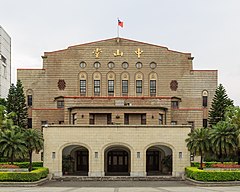Taipei Zhongshan Hall
| Zhongshan Hall | |
|---|---|
| 中山堂 | |

The Zhongshan Hall facade
|
|
| Former names | Taipei City Public Auditorium |
| Alternative names | Chungshan Hall |
| General information | |
| Location | Zhongzheng, Taipei, Taiwan |
| Address | No. 98, Yanping South Road Zhongzheng District, Taipei City 10042 Taiwan |
| Current tenants | Taipei City Government |
| Construction started | November 23, 1932 |
| Completed | November 26, 1936 |
| Technical details | |
| Floor count | 4 |
| Floor area | 113,750 square feet |
| Design and construction | |
| Architect | Ide Kaoru |
| Website | |
| www.zsh.taipei.gov.tw (in English) | |
Zhongshan Hall (Chinese: 中山堂; pinyin: Zhōngshān Táng) is a historical building which originally functioned as the Taipei (Taihoku) City Public Auditorium(public hall). It is located at 98 Yanping South Road in the Ximending neighborhood of the Zhongzheng District, Taipei, Taiwan. In 1992, it was recognized by the government as a historic site.
As a tribute to mark the ascension of the Japanese Emperor Showa in 1928, the Japanese government in Taiwan dismantled the Qing dynasty government office in Taipeh (Taipei) and began the plan to erect the Taihoku City Public Auditorium (臺北公會堂 Taihoku Kōkaidō). Construction began on November 23, 1932 and completed on November 26, 1936. Ide Kaoru, the main architect serving as Chief Engineer in Taiwan under the Japanese government, used the full cost of 980,000 Yen and 94,500 workers.
The four-story steel structure of the building was designed to be fire-resistant and to withstand severe earthquakes and typhoons. The original building was faced in light green tile to make it less visible to aerial bombers. The windows are adorned with classical designs in a Spanish Islamic style. With 44,179 square feet (4,104.4 m2) for the ground floor, the total area of the City Public Auditorium was 113,750 square feet (10,568 m2), making it the fourth largest city Public Auditorium in Japan at that time. It was smaller than only the City Public Halls of Tokyo, Osaka, and Nagoya.
After Taiwan's handover to the Republic of China in 1945 after World War II, the Chief of Taiwan Provincial Administrative Office, Chen Yi represented the Allies and accepted a formal surrender from the Japanese. The surrendering Japanese commander was Ando Rikichi, Japanese Governor of Taiwan. The former Taihoku City Public Auditorium was renamed Chungshan (Zhongshan) Hall in honor of Sun Yatsen and functioned as an official meeting place under the Chinese government.
...
Wikipedia
